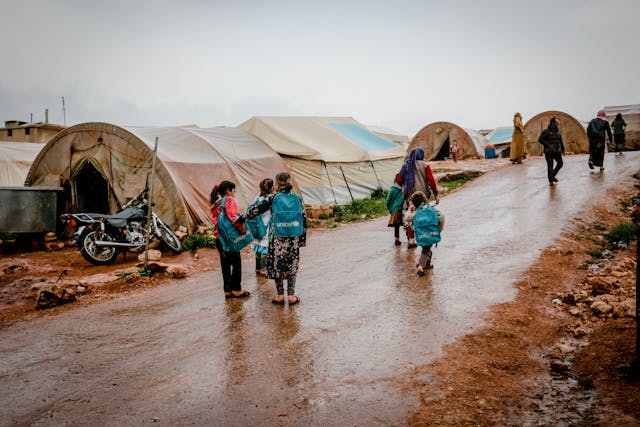
Why did the war in Syria start? The Syrian war started because the President, Bashar al-Assad put down a peaceful demonstration with violence.
The Syrian war started on 15th March 2011 and is still going on. So far, roughly 600,000 people have been killed, 300,000 of them civilians. 6.7 million people have no place to live within Syria and another 6 million also been displaced, fleeing to other countries in Europe. That is almost half of the total population of Syria. The war came to a head in the last month when President Assad’s government was overthrown and he was forced to flee to Moscow, where he has received protection. That hasn’t ended the war, though. So, what started it?
Assad was the head of a one-party government, the Arab Socialist Baath Party, in Syria. The party had been formed by his father, Hafiz al-Assad, who became the first real dictator of Syria. He wanted his family to live as a ruling dynasty. His son was elected president when Hafiz al-Assad died in 2010. The election was uncontested because there is only one party and all of the potential opposition had been suppressed.
Bashar al-Assad ran a typical dictatorship. He oppressed the people and imprisoned any potential opposition. He might have carried on doing it for longer without war if it hadn’t been for a series of revolts across the Arab world. That and global warming. It is thought that climate changed caused several severe droughts in the region, which forced a lot of rural people to move to the cites in search of food and work. This pushed up the urban population and left a lot of people living in poverty. There was a lot of dissatisfaction with Assad’s government. Inequality was widespread across Syria and the Assad government did not have a very good human rights record.
In 2010 and 11, there were several demonstrations that started in the Arab world. The first one was in Tunisia and started because of corruption in the Tunisian government. The president of Tunisia was overthrown and fled to Saudi Arabia. The demonstrations spread and within a year the leaders of Libya (Muammar Gaddafi), Egypt, and Yemen had been overthrown and either been killed or fled. It seemed like a wind of change was sweeping through the area and the unhappy people in Syria saw this as a chance to change their own country.
In March, there were several peaceful protests in Syria. The protests had begun after 15 boys had been arrested and tortured for writing graffiti in support of the revolutions in other countries. One of the boys, a 13-year-old, had died. People decided enough was enough and went to protest. In Syrian law, public gatherings of more than five people were banned, so the demonstrators were breaking the very harsh law. It should be stressed again that the demonstrations were entirely peaceful. Like most dictators, Assad could not let any kind of protest, even peaceful ones, stand because that would be the first domino to fall. The only way for a dictator to keep ruling is through fear and total control. Assad did the only thing he could think to do and had the demonstration put down. He used his security forces and they violently put down the demonstrations. They killed thousands of people and arrested tens of thousands more. With no choice but to die or fight back, the protests rapidly became violent as the protestors armed themselves.
The protestors and defectors from the Syrian army formed the Free Syrian Army and started trying to overthrow the government. By 2012, the country had fallen into civil war. Assad could possibly have been overthrown in the early days, but some other countries decided to lend their support. Some Arab countries have been helping on both sides. The US has led a global force that is trying to help the rebels and try to stop too many terrorists coming out of the country. One of the most important of these was Russia. Assad was an ally of Russia. Dictators have to stick together, of course. Russia promised to help Assad in his civil war because of that friendship, but they were also worried that if the Syrian government fell, the new government might be friendly with the west and Russia’s sphere of influence would shrink. All of these forces were fighting on several different sides and the civilian casualties skyrocketed.
The war carried on for years and the Syrian economy was decimated. So many people were starving and living in poverty. In the last month, even Assad’s security forces weren’t being paid and didn’t have enough food, so they just gave up, allowing the rebels to come in and take the government. Hopefully, now Assad had gone, there will be peace and we can start rebuilding the country. And this is what I learned today.
Try these:
Sources
https://www.bbc.com/news/world-middle-east-35806229
https://en.wikipedia.org/wiki/Syrian_civil_war
https://en.wikipedia.org/wiki/Arab_Spring
https://en.wikipedia.org/wiki/Arab_Spring
https://www.aljazeera.com/news/2018/4/14/syrias-war-explained-from-the-beginning
https://www.aljazeera.com/news/2024/12/8/what-happened-in-syria-has-al-assad-really-fallen
https://en.wikipedia.org/wiki/Russian_intervention_in_the_Syrian_civil_war
Photo by Ahmed akacha: https://www.pexels.com/photo/children-walking-in-rainy-refugee-camp-in-syria-7238309/
